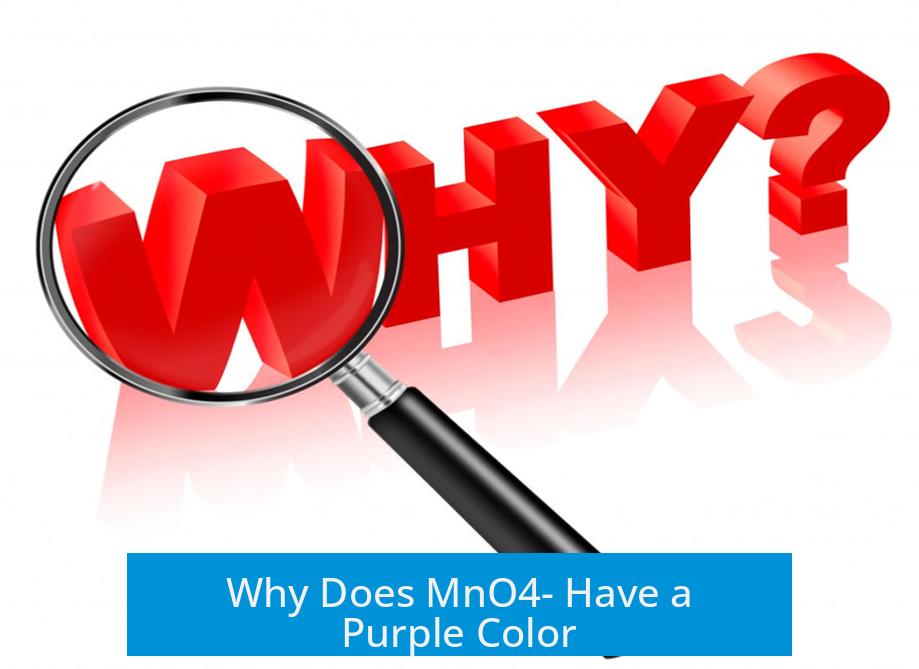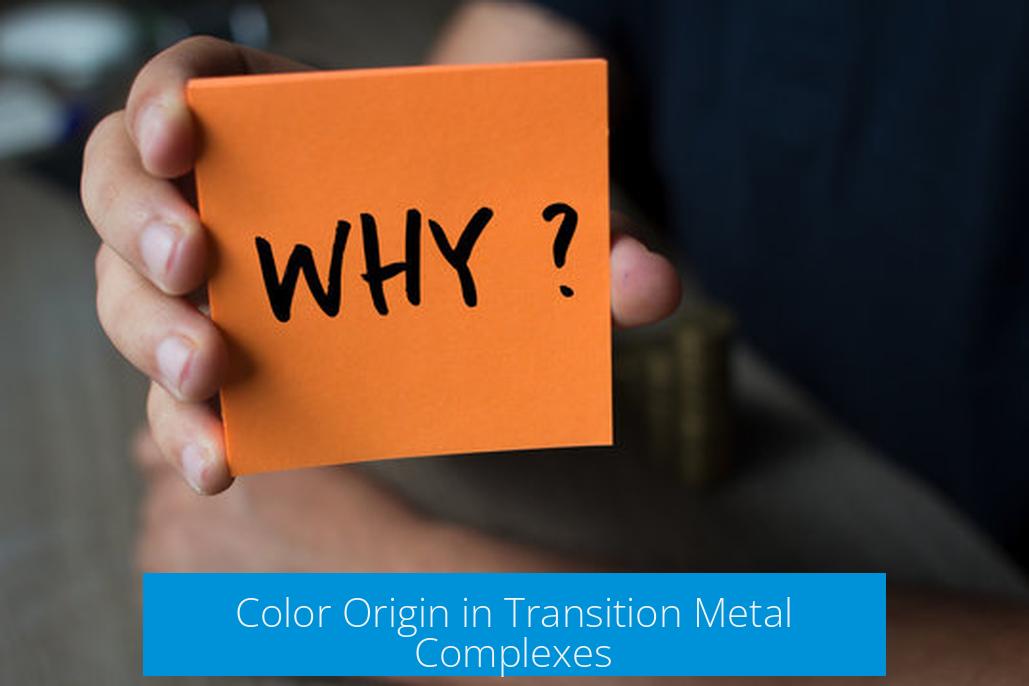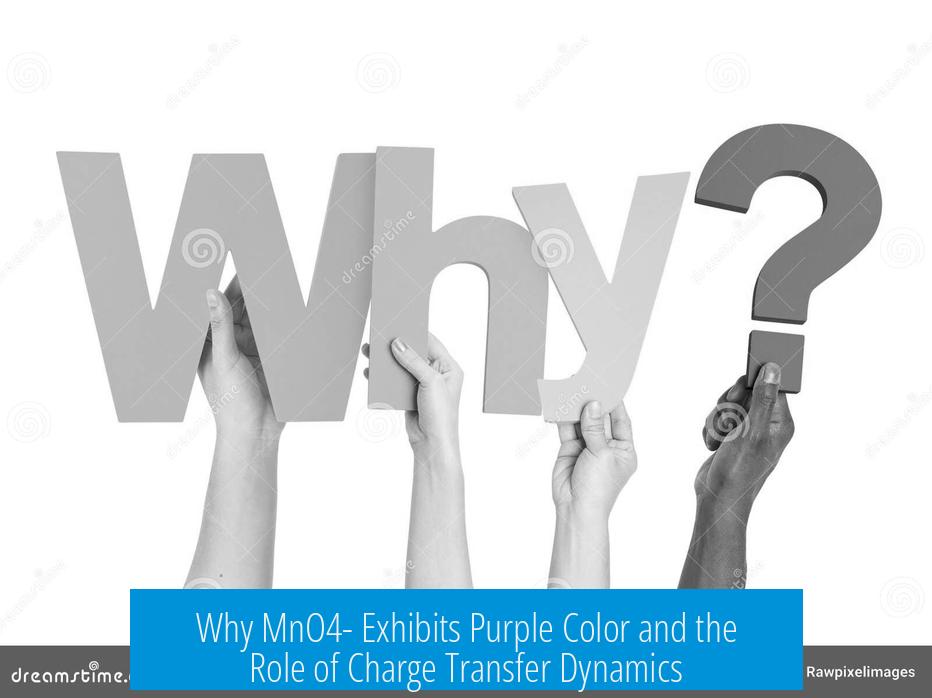Why Does MnO4- Have a Purple Color?

The purple color of the permanganate ion (MnO4-) primarily originates from intense charge transfer transitions between the oxygen ligands and the manganese center, rather than simple d–d electronic transitions within manganese.
Color Origin in Transition Metal Complexes

Colors in many transition metal complexes usually arise from electronic transitions involving d orbitals of the metal. These d–d transitions involve electrons moving between split d orbitals under the ligand field.
However, for MnO4-, such d–d transitions play a minimal role. This is because Mn is in the +7 oxidation state, which gives it a d0 electron configuration—no electrons occupy the d orbitals to transition between. Additionally, spin-forbidden transitions, though possible, are too weak to explain the intense purple color.

Charge Transfer Transitions: The Real Cause
The vivid purple arises from ligand-to-metal charge transfer (LMCT). In MnO4-, oxygen atoms act as ligands with filled p orbitals. Upon absorption of visible light, electrons transfer from these oxygen p orbitals to the empty d orbitals of manganese.

- This LMCT transition is highly allowed and thus has a strong absorption intensity.
- The energy gap corresponds to visible wavelengths, leading to the characteristic purple appearance.
- Charge transfer complexes like MnO4- often display more intense colors than ordinary d–d transitions.
Effect of Manganese Oxidation States
Manganese exhibits several oxidation states: +3, +4, +5, +6, and +7. Each state can produce distinct colors due to different electronic configurations and types of electronic transitions. For example:

| Oxidation State | Color | Example Compound |
|---|---|---|
| +3 | Red | Manganese(III) complexes |
| +5 | Blue | Manganese(V) compounds |
| +6 | Green | Manganese(VI) compounds |
| +7 | Purple (in aqueous MnO4-) | Permanganate ion |
Even within +7 oxidation state, environmental changes can alter the observed color. For instance, manganese heptoxide (Mn2O7) is intensely green rather than purple, showing the influence of molecular surroundings on charge transfer transitions.
Summary of Key Points
- MnO4- has a d0 configuration; thus d–d electronic transitions are not responsible for its color.
- The purple color results from ligand-to-metal charge transfer (LMCT) from oxygen to manganese.
- Charge transfer transitions are strong and produce vivid color intensities.
- Manganese’s oxidation state significantly influences the color of its compounds.
- Environmental and molecular structure variations alter the specific color observed even for the same oxidation state.
Why does MnO4- have a purple color?
The purple color of the permanganate ion (MnO4-) comes primarily from a Ligand-to-Metal Charge Transfer (LMCT) transition rather than the usual d-orbital electron movements typical in many transition metal complexes. If you thought it was some simple color-by-d-orbital-transitions story, think again! It’s a bit more scientific magic at play.
Let’s unpack this vivid purple mystery with some serious chemistry fun.
What’s Up with Transition Metal Colors Anyway?
Most transition metals flaunt colors thanks to electronic transitions within their d orbitals. These d-d transitions happen when electrons jump between energy levels in the metal’s d-orbitals. It sounds straightforward and is often true for many compounds, giving us blues, greens, reds, and more.
But—and this is a big “but”—this story hits a wall with MnO4-. Why? Because Mn in MnO4- sits in a +7 oxidation state, meaning its d orbitals are empty. No electrons in the d orbitals means no d-d transitions to produce color. This is one hell of a plot twist in the color tale!
Furthermore, spin-forbidden transitions, where spins flip, are technically possible but so rare and weak that they don’t contribute much to the intense purple color we see. So, our usual d-orbital explanation isn’t the belly dancer here.
Charge Transfer: The Real Star Behind the Purple Curtain
Now, the story gets juicy: the purple color of MnO4- arises because of charge transfer complexes. Specifically, Ligand-to-Metal Charge Transfer (LMCT) happens. What does that mean? The electrons jump from the oxygen ligands directly into the empty manganese orbitals.
This electron shuttle creates vibrant colors. Why? Because charge transfer transitions involve a lot more electron movement energy compared to d-d transitions, making the color intense and eye-catching. So next time you see MnO4-’s purple glow, thank the oxygen atoms gifting electrons to manganese, stirring up that rich purple hue.
Curiously, these charge transfer transitions aren’t just chemistry classroom show-offs; they are behind several dyes and pigments used in art and industry. So purple permanganate isn’t just a science curiosity—it’s a prime example of how chemistry colors our world.
A Quick Chemistry Flashback: Manganese and Its Many Shades
Manganese is like a celebrity with many outfits, displaying a rainbow of colors depending on its oxidation state and environment. For example:
- Mn(III) often shows red hues.
- Mn(V) can appear blue.
- Mn(VI) casts green shades.
- Mn(IV), like manganese dioxide, is usually brown or black but insoluble and rarely shows complex colors in solution.
The special +7 state in permanganate is famous for its purple, but oddly, this isn’t the only purple manganese game in town. Take manganese heptoxide—also Mn(VII)—which morphs into an intense green under dehydrating conditions. This proves that the molecular environment and how electrons shuffle influence color deeply, not just the oxidation number alone.
So, Why Should You Care About This?
Understanding why manganese in MnO4- is purple helps chemists predict how complexes behave and design new materials with targeted colors for practical purposes. Ever heard of dyes, catalysts, or sensors that hinge on how metal-ligand electrons dance around? This exact mechanism powers those applications.
If you’re a student or chemistry enthusiast, knowing that color doesn’t always come from d orbitals but rather sometimes from exotic charge transfer tells you to look beyond surface assumptions. Science isn’t just about memorizing facts; it’s solving puzzles like this purple one.
Quick Recap for the Color Curious:
- MnO4-’s purple isn’t from typical d-d transitions. Mn7+ is d0—no d electrons to jump around.
- Spin-forbidden transitions are too weak to matter.
- It’s the Ligand-to-Metal Charge Transfer (LMCT) that creates the vibrant purple. Oxygen ligands give electrons to manganese.
- Manganese oxidation state and environment dramatically influence color, as seen in varying hues of Mn compounds.
Fun Thought: Imagine if colors were just moods of electrons!
In MnO4-, electrons from oxygen ligands get a one-way ticket to manganese’s vacant orbitals, throwing a dazzling purple party. Without that ticket, no color spectacle. Chemistry: turning dull electrons into dazzling artists!
So next time you gaze at permanganate’s purple swirl in a lab or an industrial solution, remember it’s a story of electron journeys, forbidden spins, and color-making charge transfers. The small permanganate ion packs a big image punch, all thanks to the quirky behavior of electrons beyond ordinary d-d transitions.





Leave a Comment